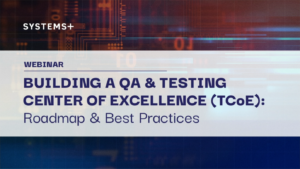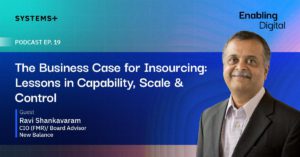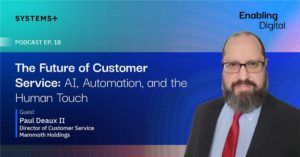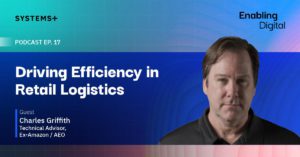Technology is advancing at a tremendous pace today, and every business is now turning into an IT company of sorts. Digital transformation is the need of the hour, and the first word that comes to mind when we think of key enablers to digital transformation, is the cloud. Having a robust cloud infrastructure means you don’t need to invest in operational centers anymore. It directly impacts the money your business makes, boosts cost efficiency and increases scalability. That’s not the best part. Most cloud computing programs ranging from CRM to productivity suites to ERP also come with flexible payments, thus making this entire process more OpEx friendly. The cloud also supports the workforce by easily enabling virtualized environments where team members can more or less set up workstations anywhere and everywhere. With seamless disaster recovery, commercial & technical flexibility, storage space and fast application deployment, digital transformation remains incomplete without a proper cloud setup.
There is another side to the story tough. The biggest hurdle CIOs probably face, is that businesses know that they need to transform digitally, but they are on tenterhooks when it comes to deciding on how or where to start. It’s their job to identify the correct drivers, motivations and improvement areas to develop a cloud strategy that fits well within the existing digital ecosystem. Licensing and bandwidth costs, storage capabilities and complex data integration all need to be charted out, and of course, none of this can happen without a skilled technical team to supervise these implementations in real time.
It’s important to think about building cloud systems in a manner that allows emerging technologies to be plugged in as they arise. CIOs should also be thinking about creating best practices that can be reused, adding to the scalability factor. It is also important to put data governance and quality at the heart of your business strategy, else it’s simply “garbage in, garbage out” which will impact business performance down the line. As more than half of IT spend becomes cloud based and security takes the lead, tech leaders also need to take care of rules like GDPR when devising cloud strategies. Only when you can ensure your end-customers that their data is safe and secure can you consider this transformation fruitful.
There are other important questions that need to be asked. What part of your traditional infrastructure do you migrate first, since shifting it all at once may not possible? What are the potentially hidden costs? Do you want these DX efforts to take over traditional IT, or do you want a mix of both? There are so many models to pick and choose from, that you might end up getting confused. Choosing between SaaS, PaaS and IaaS is the first step. Think of it as choosing whether to dine out, get dinner home delivered, or cooking it yourself.
Let’s take the example of the fast food giant McDonalds and their digital transformation journey. With one of the biggest supply chains in the world, every order adds on to the customer data being collected. With more than 100 markets, 1000 integration jobs and 10,000 users across technologies, siloed data became a problem and reducing friction was imperative. They used native services from AWS as their primary cloud solutions, but also backed it up with Azure for its data analytics capabilities. Thus, they set up a seamless multi cloud set up and within the course of a year were able to create a platform that helped them scale up while ensuring proper data compliance, governance and security. That’s what you call innovation.
Another critical decision is to decide whether one should be on public, private or hybrid cloud. While public cloud is easy to manage and offers increased scalability, a private cloud brings greater control and better security for mission-critical data. Hybrid cloud brings the best of both worlds, merging public and private cloud for lower total cost of ownership (TCO) and enhanced security. Some applications may need to remain on-premises or in a private cloud due to security and regulatory requirements, while other data can be more easily stored in the public cloud. This is where typically choosing the right service provider to support these decisions becomes critical.
Most businesses seem to be migrating towards a hybrid cloud arrangement because it’s the perfect combination of efficiency and effectiveness. It allows you to transition at your own pace and simplifies things a bit because moving applications is not just a lift and shift. It allows you to start small. A public web site, a small application with few security requirements or something as simple as your office automation tools – think where you are headed and then start the transformation. Educating your entire organization about the pros and cons of hybrid cloud is also up to you, otherwise these efforts are as good as futile. Moving to the cloud is not an IT decision, it’s a business decision. Knowledgeable support is the need of the hour because ultimately it is the operational teams that will drive this forward.
Mostly, businesses opt for the big three, namely AWS, Microsoft Azure and Google cloud. However, there’s also a new kid on the block. In only a few years, Alibaba cloud has made its mark. How you choose between these providers depends on whether you are looking for entry level solutions or enterprise level growth.
For high-end computational services, it does not get better than AWS which comes with pay-as-you-go services along with over a hundred different offerings. However, you will need to be familiar with the hybrid cloud infrastructure to determine how the AWS suite of services can be best utilized during migration. While, overall, AWS is easy to use and has one of the simplest operating consoles, you may have a bit of an issue with data movement. When it comes to testing tools and building IoT apps, the private cloud backed Azure is another viable option especially now since it’s compatibility with non-Microsoft platforms has improved tremendously. Alibaba cloud has had a growth trajectory which is unparalleled and with more than 360,000 transactions per second, its capabilities are directly competing with AWS, however their presence has predominantly been Far East based and their local service centers have not been around for as long as the rest of the players. Each of these services have their set of pros and cons and it takes specially trained solution architects to define which is the “right” way to go for your organization.
No one said it would be easy, but innovation and disruption is the only way ahead. While the road to a successful cloud migration is daunting alone, the journey becomes easier when you have someone to guide you through. With more than three decades of experience in legacy and record-based systems, traditional architecture, hybrid environments, we’ve seen it all. Our gamut of technical capabilities extends across cloud consulting, cloud architecture and management, enterprise cloud solutions, containerization & microservices and helping businesses chart out customized adoption frameworks. You don’t have to look much further to #GetITRight!






